|
 Ooparts:
(Out of Place Artefacts)
Ooparts:
(Out of Place Artefacts)
"If a
single, well verified mammal skull were to turn up in 500 million year
old rocks, our whole modern theory of evolution would be utterly
destroyed": (Quote: Richard Dawkins).
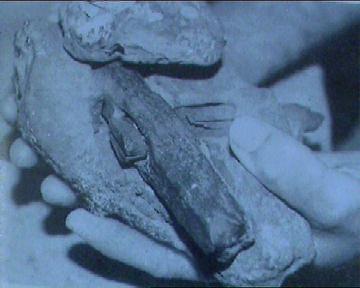
This contentious group of anomalous
artefacts
includes anthropomorphic discoveries which have been found in geological strata
formed before humans are believed to have existed.
At present, all the
following artefacts are classified as 'anomalous' or 'fake'. Should just one
of these discoveries ever be verified by the scientific establishment, it
would force a reappraisal of either the processes of
geology or the theory of human development.
This fossilised
hammer (right) was found embedded in a rock. It was displayed in 2000
and is verified as authentic but what exactly does it tell
us.
|
Ooparts: A Catalogue of Anomalous Discoveries: |
The Baigong Pipes, China.
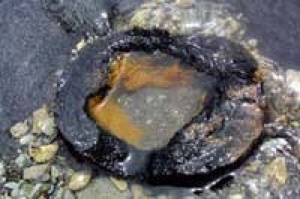 The Baigong Cave in China
is
the location of numerous ancient underground 'metal pipes' that were
discovered in the beginning of the 20th century. Traditional
science has provided one or two explanations for their presence,
but as yet there is no definite answer as to how or why the
pipes exist where they do, as they run through the ground and
even into the nearby lake. The Baigong Cave in China
is
the location of numerous ancient underground 'metal pipes' that were
discovered in the beginning of the 20th century. Traditional
science has provided one or two explanations for their presence,
but as yet there is no definite answer as to how or why the
pipes exist where they do, as they run through the ground and
even into the nearby lake.
There is no
evidence of an associated pyramid, as is normally reported, but
the idea that they are fossilised tree roots remains
unsatisfactory making the Baigong pipes one of todays more
interesting modern O.O.P.Arts.
(More
about the Baigong Pipes)
The 'London'
Hammer, Texas, USA:
The fossilised 'London
Artefact' has gained notoriety in
recent years following its display in an exhibition of anomalous artefacts
in the year 2000. It is a perfect example of the anomalous nature of some
archaeological discoveries. On the one hand, we are presented with a
hammer, clearly of human design; While on the other hand, it is embedded in
a rock found in a region formed of predominantly cretaceous rock.

The Facts:
The rock was found in June, 1934 sitting loose on a rock
ledge beside a waterfall near London, Texas.
(4)
The site is part of a large geographical
zone called the Edwards Plateau. It primarily consists of Cretaceous rock. (4)
A recent radiocarbon-dating test was
performed on a sample of wood removed from the interior of the handle. The
results showed inconclusive dates ranging from the present to 700 years ago.
(4)
The sandstone, within which the hammer has become
embedded was dated by dr. A. W. Med of the British Geological Research
Centre.
The Hammer is identical to commonly
used 19th century miners hammers, of American provenance.
It was soon pointed out by the
geologist NCSE researcher John Cole that minerals dissolved from ancient
strata can harden around a recent object
(5), making it look impressive to someone unfamiliar with
geological processes .
He said of it:
The stone is real, and it looks
impressive to someone unfamiliar with geological processes. How could a
modern artefact be stuck in Ordovician rock? The answer is that the
concretion itself is not Ordovician. Minerals in solution can harden around
an intrusive object dropped in a crack or simply left on the ground if the
source rock (in this case, reportedly Ordovician) is chemically soluble
(Cole, 1985).
|
Some other Examples:
Chains in
Coal: Workmen quarrying stone near the
River Tweed below Rutherford, Scotland in 1844, found a piece of gold
thread embedded in the rock of the quarry eight feet below ground
level. A small piece of the thread was sent to the offices of the
local newspaper, the Kelso Chronicle, "for the inspection of
the curious."
(The Times,
London, June 22, 1844)
Mrs. S. W. Culp, of
Morrisonville, Illinois, was breaking coal into smaller lumps for her
scuttle, one day in 1891, when she noticed a chain in the midst of the
coal. When she reached down to pick it up, she saw that the two ends
of the chain were firmly embedded in two separate pieces of coal that
had clearly been a single lump only moments before.
(The Morrosonville
Times, June 11, 1891)
Iron Nails:
In 1851, Hiram de Witt, of
Springfield, Massachusetts, accidentally dropped a fist sized piece of
gold bearing quartz that he had brought back from California. The rock
broke apart in the fall, and inside it de Witt found a 2" cut iron
nail, slightly corroded. "It was entirely straight and had a perfect
head," reported The Times of London.
(The Times, London,
December 24, 1851)
A nail partially
embedded in a block of stone taken from Kingoodie quarry in Scotland
was described at a meeting of the British Association for the
Advancement of Science in 1845, Sir David Brewster, who gave the
report, said that about an inch of the nail was embedded, the rest
lying along the stone and projecting into a layer of gravel, where it
had rusted. The depth from which the 9" thick block of stone bearing
the nail had been removed is not on record, but the quarry was said to
have been worked for about twenty years prior to the discovery.
(Charles Fort, The
Complete Books of Charles Fort, pg. 133)
An "iron instrument"
apparently resembling the bit of a coal drill, was found inside a lump
of coal taken from an excavation in Scotland in 1852 (Scotland
again!). It was at first supposed that a miner had broken his drill
while working the seam and had left the piece of metal embedded there.
But the surface of the coal was unbroken: it showed no signs of
drilling or any present or former opening by which the drill might
have passed into it's interior. If such a thing were not quite
impossible, according to every date in the geology text books,
observers would have to believe that the coal would somehow have
formed around the mysterious piece of metal.
(Proceedings of the
Society of Antiquaries of Scotland, 1:1:121, December 13, 1852
|
France: Tools in Rock
Extensive quarrying was
done near the city of Aixen -Provence, France between 1786 and 1788,
to provide the large quantities of limestone needed for the rebuilding
of the Palace of Justice. In the quarry from which the limestone was
taken, the rock strata were separated from each other by layers of
sand and clay, and by the time the workmen had removed 11 layers of
rock they had found they had reached a depth of some 40 feet or 50
feet from the original level of the area.
Beneath the 11th layer of limestone they came to a bed of sand and
began to remove it to get at the rock underneath. But in the sand they
found the stumps of stone pillars and fragments of half worked rock,
the same stone and rock that they themselves had been excavating. they
dug further and found coins, the petrified wooden handles of hammers,
and pieces of other petrified wooden tools. Finally they came to a
large wooden board, seven or eight feet long and an inch thick. like
the wooden tools, it had also been petrified into a form of agate and
it had been broken into pieces. When the pieces were reassembled, the
workmen saw before them a quarryman's board of exactly the same kind
they themselves used, worn in just the same way as their own boards
were, with rounded, wavy edges.
How a
stonemason's yard equipped with the kind of tools used in France in
the late18th century, had come to be buried 50 feet deep under layer
of sand and limestone 300 million years old is a question even more
vexing today than at the time of the original discovery. For we now
know, thanks to advances in geological and anthropological dating,
that such a thing is absolutely impossible. And yet it does seem to
have happened.
(The American
Journal of Science and Arts, 1:145-46, 1820)
|
The South African spheres
- 'The Klerksdorp Spheres':
Quote from (1) - 'Over the past several decades, South African miners
have found hundreds of metallic
spheres, at least one of which has three parallel grooves running around its
equator. The spheres are of two types - "one of solid bluish metal with
white flecks, and another which is a hollow ball filled with a white spongy
centre" (Jimison, 1982). The sphere
in the photo (right), was found in a Precambrian mineral deposit, making it
an unlikely 4,500 Million years years old. Some of the spheres
can be seen in the Museum at Klerksdorp, South Africa.
(1)
At least 200 have been found, and extracted out of deep
rock at the Wonderstone Silver Mine in South Africa, averaging 1-4 inches in
diam. and composed of a nickel-steel alloy that doesn't occur naturally.
Some have a thin shell about a quarter inch thick, when broken open are
filled with a strange spongy material that disintegrates into dust upon
contact with air.
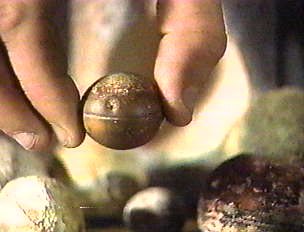

The following is an extract from a letter. (Apparently
from a NASA scientist) : Unconfirmed.
'The existence of the sphere came to my attention ca 1977 while removing
endangered rock engravings from the site where pyrophyllite or "wonderstone",
as it is commonly known in the region, is mined on the farm Gestoptefontein
(meaning plugged fountain) near the little village of Ottosdal about 110 km
from Klerksdorp in South Africa's Northwest Province.
I was intrigued by the form of the spheres, grooves around the middle and
the fact that they are as hard as steel, while the material (pyrophyllite)
in which they are found, is as soft as limestone with a count of only 3 on
the Mohr scale. As you probably know, pyrophyllite (Al2 Si4 O10 (OH)2) is a
secondary mineral and the deposits were formed by a process of
sedimentation. On Gestoptefontein volcanic activity was responsible for the
forming of outcrops varying in height from about 10 to 100 meters. The
smooth and relatively soft surface on the slopes were ideal for the
prehistoric dwellers (San) to make their engravings of animal and abstract
designs.
On Gestoptefontein these outcrops were "sawn" into huge pieces by means of
twisted steel cables running zig-zag on pulleys for several kilometres.
These blocks were then sawn by the same method into more manageable pieces
of about 500 x 500 mm. Occasionally the "sawing cable" got stuck on one of
the metal spheres embedded in the pyrophyllite.
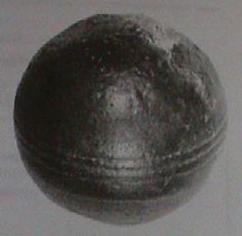 They vary in size from " 30 � 50 mm in diameter and have perfectly
concentric grooves round the center as if they were molded. Inside the hard
"shell" some have a spongy substance, while in others it resembles
charcoal.
When only partly embedded so that they can be seen on the surface, they are
not all spheres, but some are also oblong in form. They vary in size from " 30 � 50 mm in diameter and have perfectly
concentric grooves round the center as if they were molded. Inside the hard
"shell" some have a spongy substance, while in others it resembles
charcoal.
When only partly embedded so that they can be seen on the surface, they are
not all spheres, but some are also oblong in form.
According to Professor Andries Bisschoff of the University of Potchefstroom
(retired some years ago) they are limonite concretions. Due to the relative
scarcity of the spheres and the almost impossibility for outsiders to obtain
samples from the mine, his conclusions have not been verified by other
scientists'.
(Click
here for full article)
(Other Examples of Metallurgy in
Prehistory)
|

The 'Dorchester Pot - The June issue of Scientific American (Vol 7,
1851. p.298), reports that a 'metallic
vase' had been dynamited out of solid rock on Meeting Hill in
Dorchester, Massachusetts. The story said, 'on putting the two parts
together it formed a bell-shaped vessel, 4 � inches high, 6 � inches at the
base, 2 � inches at the top and about an eighth of an inch in thickness".
The body of the vessel resembles zinc in colour, or a composition metal in
which there is a considerable portion of silver. The vessel is chased,
carved and inlayed exquisitely. (9)
This particular discoveries illustrates the way mistakes
can be made. There is little doubt that what was discovered was the remains
of a contemporary 'candlestick' similar to the one on the right.
(View original
Scientific American Article)
|
1961
- The 'Coso Artefact'
-
(NOW BELIEVED TO BE A FAKE)
(3)
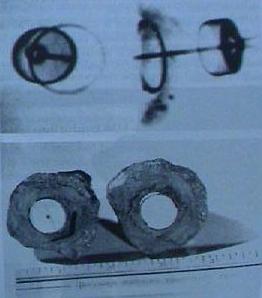 The story goes that rock hunters collecting geodes in Olancher, California cut a stone in half
to discover a form of mechanical device. Beneath the outer layer of
hardened clay, pebbles, and fossil inclusion was a hexagonal layer of an
unknown substance softer than agate or jasper. This layer surrounded a
three-quarter-inch-wide cylinder made of solid porcelain or ceramic, and in
the centre of the cylinder was a 2mm shaft of bright metal. This shaft was
magnetic and showed no signs of oxidation. Circling the ceramic cylinder
were rings of copper, and these also had not corroded. X-ray photography
(right, top), showed that the metallic shaft was corroded at one end, but
the other was affixed to a spring or helix of metal. (9). The story goes that rock hunters collecting geodes in Olancher, California cut a stone in half
to discover a form of mechanical device. Beneath the outer layer of
hardened clay, pebbles, and fossil inclusion was a hexagonal layer of an
unknown substance softer than agate or jasper. This layer surrounded a
three-quarter-inch-wide cylinder made of solid porcelain or ceramic, and in
the centre of the cylinder was a 2mm shaft of bright metal. This shaft was
magnetic and showed no signs of oxidation. Circling the ceramic cylinder
were rings of copper, and these also had not corroded. X-ray photography
(right, top), showed that the metallic shaft was corroded at one end, but
the other was affixed to a spring or helix of metal. (9).
Research by Pierre Stromberg
and Paul Heinrich of the Pacific Northwest Sceptics has shown that it can in
fact be identified with a spark plug manufactured by Champion in the 1920s.
(3)
(Electricity in Prehistory) |
Table-Top Mountain (California):
1899
- Smithsonian institute initiate a survey of anomalous artefacts that
'appear to come from gravels dating 38-55m yrs from 'Table-top mountain'.
Finds include: spear
heads 6-8'' long, ladles and handles,
notched slate object
(possibly for a bow),
stone grinding tool, human jaw
(33-35 m yrs), Mastodon tooth, � '' perforated, white marble bead, stone
axe, Andesite stone mortars (nearest source 100 miles).
|
The Cambodian 'Stegosaurus'.
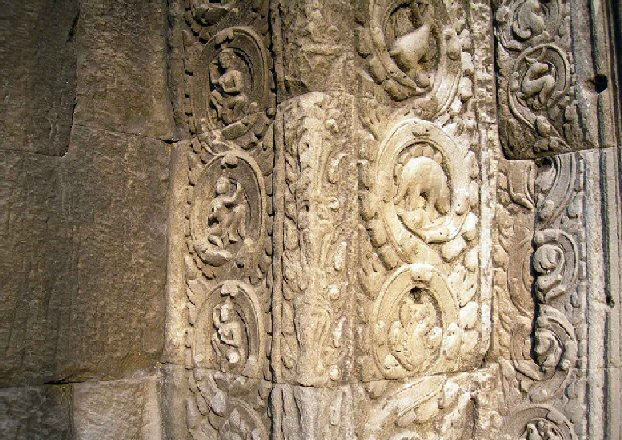
This carved facade can be seen in
the temples of Ta Prohm,
Cambodia. (Dated 11th Cent AD).
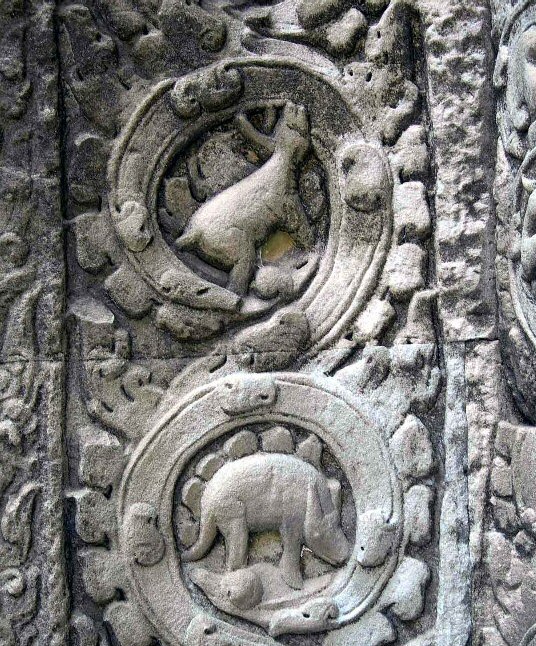
A Close-up reveals the image of a Stegasorus.
We know that it is an original carving as the
depth of the relief is the same as the rest of the facade.
(Link to
Original Article) |
| Fossilised Human
Footprints: |
The topic of dinosaur and human footprints side
by side sends an understandable shudder down the spines of
Geologists worldwide, but try as they might to turn their back on
it, the subject just won't go away.
There are of course several fully accepted
cases of fossilised human footprints but they all date from
before Mary Leaky's discovery of the 'Lucy' footprint in
Laetoli, which is estimated at 3.7 million years old. This is
currently the oldest un-refuted humanoid footprint on record.
All other footprint from rock strata from before this date are
considered hoaxes or coincidences. The following examples
are a selection of accredited reports of human footprints (remains)
in strata older than 3.7 million years:
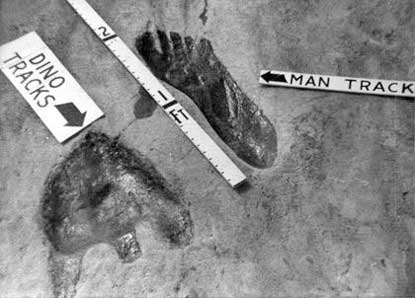
Example 1:
In 1983
Professor Amanniyazov, Director of Turkmenia's Institute of Geology,
reported what appeared to be human footprints in Mesozoic strata.
"This spring, an expedition from the Institute of Geology of the
Turkmen SSR Academy of Sciences led by found over 1,500 tracks left
by dinosaurs in the mountains in the south-east of the Republic.
Impressions resembling in shape a human footprint were discovered
next to the tracks of the prehistoric animals." (Rubstsov, "Tracking
Dinosaurs," Moscow News, No. 24, p. 10, 1983.) Dr.
Amanniqazov was shocked beyond belief to find a human footprint
mingled with dinosaurs. He discusses one of the footprints and says:
"if we speak of the human footprint, it was made by a human or a
human-like animal. Incredibly, this footprint is on the same plateau
where there are dinosaur tracks. We can say the age of this
footprint is not 5 or 10, but at least 150 million years old. It is
26cm long, that is Russian size 43 EEE [9.5 American], and we
consider that whoever left the footprint was taller than we
are...this would create a revolution in the science of man." (Amanniyazov,
Kurban, Science in the USSR T 986, "Old Friends Dinosaurs," p.
103-107.) There is also this fascinating quote from the Russian
journalist, Alexander Bushev who investigated these trackways: "But
the most mysterious fact is that among the footprints of dinosaurs,
footprints of bare human feet were found...We know that humans
appeared much later than dinosaurs - that there was an
extraterrestrial who walked in his swimming suit along the sea
side."
(Bushnev,
Alexander, Komsomolskya Pravda, January 31, 1995, p. 61ff.)
 Example
2: The
Image (right) is from the Zapata track, found in Permian limestone
in New Mexico. In 1987, not far from the Zapata track site,
paleontologist Jerry MacDonald discovered a variety of beautifully
preserved fossil footprints in Permian strata. The Robledo Mountain
site contains thousands of footprints and invertebrate trails that
represent dozens of different kinds of animals. Because of the
quality of preservation and sheer multitude of different kinds of
footprints, this tracksite has been called the most important Early
Permian sites ever discovered. Some that have visited the site
remark that it contains what appears to be a barefoot human print.
"The fossil tracks that MacDonald has collected include a number of
what paleontologists like to call �problematica.� On one trackway,
for example, a three-toed creature apparently took a few steps, then
disappeared--as though it took off and flew. 'We don't know of any
three-toed animals in the Permian,' MacDonald pointed out. �And
there aren't supposed to be any birds.� He's got several tracks
where creatures appear to be walking on their hind legs, others that
look almost simian. On one pair of siltstone tablets, I notice some
unusually large, deep and scary-looking footprints, each with five
arched toe marks, like nails. I comment that they look just like
bear tracks. �Yeah,� MacDonald says reluctantly, �they sure do.�
Mammals evolved long after the Permian period, scientists agree, yet
these tracks are clearly Permian." Example
2: The
Image (right) is from the Zapata track, found in Permian limestone
in New Mexico. In 1987, not far from the Zapata track site,
paleontologist Jerry MacDonald discovered a variety of beautifully
preserved fossil footprints in Permian strata. The Robledo Mountain
site contains thousands of footprints and invertebrate trails that
represent dozens of different kinds of animals. Because of the
quality of preservation and sheer multitude of different kinds of
footprints, this tracksite has been called the most important Early
Permian sites ever discovered. Some that have visited the site
remark that it contains what appears to be a barefoot human print.
"The fossil tracks that MacDonald has collected include a number of
what paleontologists like to call �problematica.� On one trackway,
for example, a three-toed creature apparently took a few steps, then
disappeared--as though it took off and flew. 'We don't know of any
three-toed animals in the Permian,' MacDonald pointed out. �And
there aren't supposed to be any birds.� He's got several tracks
where creatures appear to be walking on their hind legs, others that
look almost simian. On one pair of siltstone tablets, I notice some
unusually large, deep and scary-looking footprints, each with five
arched toe marks, like nails. I comment that they look just like
bear tracks. �Yeah,� MacDonald says reluctantly, �they sure do.�
Mammals evolved long after the Permian period, scientists agree, yet
these tracks are clearly Permian."
("Petrified Footprints: A Puzzling Parade of Permian Beasts," The
Smithsonian, Vol. 23, July 1992, p.70.)
Example 3:
The 'Guadeloupe Woman' is a
well-authenticated discovery which has been in the British
Museum for over half a century. In 1812, on the coast of the
French Caribbean island of Guadeloupe, a fully human skeleton
was found, complete in every respect except for the feet and
head. It belonged to a woman about 5 foot 2 inches [15.54 dm]
tall.
What makes it of great significance is the
fact that this skeleton was found inside extremely hard, very
old limestone, which was part of a formation more than a mile
[1.609 km] in length! Modern geological dating places this
formation at 28 million years old�which is 25 million
years before modern man is supposed to have first appeared on
earth!
Since such a date for a regular person does
not fit evolutionary theory, you will not find "Guadeloupe
Woman" mentioned in the Hominid textbooks. To do so would be
to disprove evolutionary dating of rock formations.
When the two-ton limestone block, containing
Guadeloupe Woman, was first put on exhibit in the British Museum
in 1812, it was displayed as a proof of the Genesis Flood. But
that was 20 years before Lyell and nearly 50 years before
Darwin. In 1881, the exhibit was quietly taken down to the
basement and remains there to this day.
Smithsonian Acknowledges Problem.
In 1987, palaeontologist Jerry MacDonald discovered
a wide variety of fossilized tracks from several different species of
animals and birds, located in a Permian strata. Among the various
fossilized tracks were the clear prints of a human foot.
However, the Permian strata has been dated from 290
to 248 million years ago- millions of years before animals, birds,
dinosaurs, and yes, man, was supposed to exist. How then can these
prints be explained?
In July 1992, the Smithsonian Magazine had an
article on these tracks called "Petrified Footprints: A Puzzling
Parade of Permian Beasts".[1] The magazine acknowledged the
mystery, acknowledging "what palaeontologists like to call,
'problematic.'" It described what appeared to be large mammal and bird
tracks that, "evolved long after the Permian period, yet these tracks
are clearly Permian."
While it is commendable that MacDonald and the
Smithsonian clearly acknowledge the existence of these tracks in a
strata that contradicts the current evolutionary theory, it is
noteworthy that they highlight only the mammal and bird prints, and
don't mention the human footprint found with them.
Interestingly enough, since these tracks been
discovered, evolutionists have not tried to argue their authenticity
or debunk them. Nor have they tried to argue that the footprint isn't
human. (Often they claim that it's a print that just "looks like" a
human footprint.) Their silence is deafening.
[1] See "Petrified Footprints: A
Puzzling Parade of Permian Beasts" by Jerry MacDonald,
Smithsonian, July 1992, Vol. 23, Issue 4, p. 70-79
|

 The Baigong Cave in China
is
the location of numerous ancient underground 'metal pipes' that were
discovered in the beginning of the 20th century. Traditional
science has provided one or two explanations for their presence,
but as yet there is no definite answer as to how or why the
pipes exist where they do, as they run through the ground and
even into the nearby lake.
The Baigong Cave in China
is
the location of numerous ancient underground 'metal pipes' that were
discovered in the beginning of the 20th century. Traditional
science has provided one or two explanations for their presence,
but as yet there is no definite answer as to how or why the
pipes exist where they do, as they run through the ground and
even into the nearby lake. 








 Example
2: The
Image (right) is from the Zapata track, found in Permian limestone
in New Mexico. In 1987, not far from the Zapata track site,
paleontologist Jerry MacDonald discovered a variety of beautifully
preserved fossil footprints in Permian strata. The Robledo Mountain
site contains thousands of footprints and invertebrate trails that
represent dozens of different kinds of animals. Because of the
quality of preservation and sheer multitude of different kinds of
footprints, this tracksite has been called the most important Early
Permian sites ever discovered. Some that have visited the site
remark that it contains what appears to be a barefoot human print.
"The fossil tracks that MacDonald has collected include a number of
what paleontologists like to call �problematica.� On one trackway,
for example, a three-toed creature apparently took a few steps, then
disappeared--as though it took off and flew. 'We don't know of any
three-toed animals in the Permian,' MacDonald pointed out. �And
there aren't supposed to be any birds.� He's got several tracks
where creatures appear to be walking on their hind legs, others that
look almost simian. On one pair of siltstone tablets, I notice some
unusually large, deep and scary-looking footprints, each with five
arched toe marks, like nails. I comment that they look just like
bear tracks. �Yeah,� MacDonald says reluctantly, �they sure do.�
Mammals evolved long after the Permian period, scientists agree, yet
these tracks are clearly Permian."
Example
2: The
Image (right) is from the Zapata track, found in Permian limestone
in New Mexico. In 1987, not far from the Zapata track site,
paleontologist Jerry MacDonald discovered a variety of beautifully
preserved fossil footprints in Permian strata. The Robledo Mountain
site contains thousands of footprints and invertebrate trails that
represent dozens of different kinds of animals. Because of the
quality of preservation and sheer multitude of different kinds of
footprints, this tracksite has been called the most important Early
Permian sites ever discovered. Some that have visited the site
remark that it contains what appears to be a barefoot human print.
"The fossil tracks that MacDonald has collected include a number of
what paleontologists like to call �problematica.� On one trackway,
for example, a three-toed creature apparently took a few steps, then
disappeared--as though it took off and flew. 'We don't know of any
three-toed animals in the Permian,' MacDonald pointed out. �And
there aren't supposed to be any birds.� He's got several tracks
where creatures appear to be walking on their hind legs, others that
look almost simian. On one pair of siltstone tablets, I notice some
unusually large, deep and scary-looking footprints, each with five
arched toe marks, like nails. I comment that they look just like
bear tracks. �Yeah,� MacDonald says reluctantly, �they sure do.�
Mammals evolved long after the Permian period, scientists agree, yet
these tracks are clearly Permian."